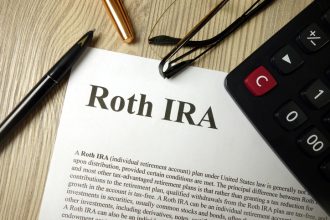Adequate savings are the foundation of any happy, sustainable retirement and the essential building block for any successful retirement plan. Research from What the Happiest Retirees Know shows that the happiest retirees on the block (HROBs) average $1.25 million annually in liquid retirement savings (adjusted for inflation through 2023). While money may not be the primary source of happiness, it does provide opportunity, flexibility, and choice to those who have worked diligently to save it. However, choosing savings alone (without investing) when it comes to funding retirement can be a costly mistake and can significantly impact your future wealth.
Savings Alone Typically Won’t Cut It—Become A Tomorrow Investor
For most families, earning a living is difficult enough even before attempting to save 10 or 20% of their income per year. It’s no wonder that nearly 70% of Americans aged 65-69 have less than $100,000 saved for retirement.
Once a family finally and painstakingly crosses the threshold of excess income, there’s often a guarded apprehension to protect those savings at all costs. News headlines and stock market updates frequently play to our greatest fears about the state of the world and can accelerate this foreboding instinct to hoard our savings somewhere safe. In fact, according to research published in the PLOS One Journal, the sentiment of news headlines over the past 20 years has become more unsettling at a degree higher than 300%.
However, the potential downside of folks leaning into this “play it safe” mentality is that, unless their paychecks are colossal, standard savings accounts, or even money market funds, rarely compound a rate high enough to build a substantial retirement stockpile. Cash assets have historically not even kept up with the rate of inflation. The speed of inflation varies, but the direction does not: our cost of living historically ticks up over time. Protecting purchasing power requires future retirees to stay ahead of it. Sprinting is unnecessary, but jogging can be more productive than crawling.
For educational purposes, the chart above shows Jack as a saver and Jill as an investor. Each managed to save $1,000 per month for 32 years. Thumbs up. That’s Yeoman’s work.
Jack remembers the early mornings, the rush hour traffic, and the micromanaging bosses he had to endure to build his nest egg. He shoves all his money into an airtight savings account and breathes a sigh of relief. “There,” he thinks. “It’s safe.” The good news for Jack is that his money probably isn’t going anywhere. But that’s also the bad news. He could likely see a meager 1% average compounded return if he sticks with “cash-like” investments.
Jill also poured blood, sweat, and tears into working and saving, but she was willing to make one small change. Instead of nervously stuffing her sum in a money market, she invested it in a broadly diversified stock-based index mutual fund or exchange-traded fund (ETF). Using the DQYDJ S&P 500 calculator to compute long-term annualized total return (dividends reinvested) for the S&P 500 from December of 1991 until the end of 2023 provides a reference point of how the broad market (S&P 500) has performed historically. During this 32 period, it gained an average of slightly more than 10% per year. It’s reasonable to assume, therefore, that Jill was able to grow her money at a 10% rate per year over her 32-year timeframe.
Assuming Jack the saver stuck with his original plan and saw a 1% rate of return for 32 years, he would have landed just north of $451,000. On the other hand, if Jill the investor enjoyed a 10% annual rate of return for the same duration, she would’ve crossed the finish line with more than $2.4 million. The contrast is stark, and the implications for a happy retirement are clear.
Remember, the point is to have self-generated income once you stop receiving an employer-based one. Jack and Jill both worked hard and saved diligently. The distinction was where they deposited their money after acquiring it. Jack was a saver. Jill was a saver and an investor.
There are no guarantees with investing, but this one change made a nearly $2 million difference between Jack and Jill.
Happy retirees are “tomorrow investors” and realize the insufficient rewards of saving alone. They keep an emergency stash, which is entirely prudent and tactically sound. However, the bulk of their retirement funds are invested in assets that have the potential to appreciate and outpace inflation over time. This includes real estate, equities, and businesses for extended periods. The task is arduous, but harnessing the long-term investment potential of the Army of American Productivity makes the journey more promising.
No one has a crystal ball to predict the stock market, but history provides a guide that could suggest time and patience are on the investor’s side. While Jack was smart to save for tomorrow, Jill’s future was brighter in our example because she was both a saver and an investor which resulted in returns that far surpassed Jack’s. Jack and Jill certainly struggled up the same hill, but in the end they landed will very different results.
This information is provided to you as a resource for informational purposes only and is not to be viewed as investment advice or recommendations. Investing involves risk, including the possible loss of principal. There is no guarantee offered that investment return, yield, or performance will be achieved. Stock prices fluctuate, sometimes rapidly and dramatically, due to factors affecting individual companies, particular industries or sectors, or general market conditions. For stocks paying dividends, dividends are not guaranteed, and can increase, decrease, or be eliminated without notice. Fixed-income securities involve interest rate, credit, inflation, and reinvestment risks, and possible loss of principal. As interest rates rise, the value of fixed-income securities falls. Past performance is not indicative of future results when considering any investment vehicle. This information is being presented without consideration of the investment objectives, risk tolerance, or financial circumstances of any specific investor and might not be suitable for all investors. There are many aspects and criteria that must be examined and considered before investing. Investment decisions should not be made solely based on information contained in this article. This information is not intended to, and should not, form a primary basis for any investment decision that you may make. Always consult your own legal, tax, or investment advisor before making any investment/tax/estate/financial planning considerations or decisions. The information contained in the article is strictly an opinion and it is not known whether the strategies will be successful. The views and opinions expressed are for educational purposes only as of the date of production/writing and may change without notice at any time based on numerous factors, such as market or other conditions.
Read the full article here
















